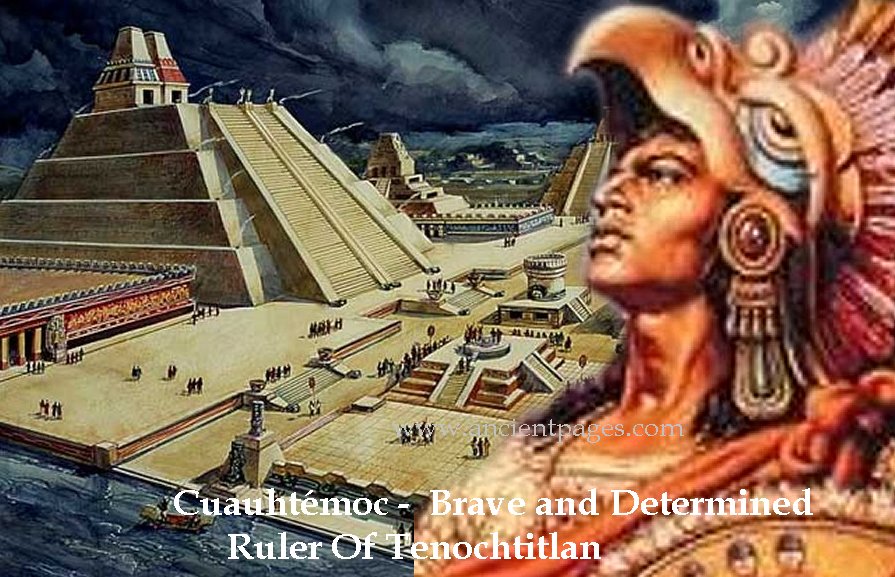Cuauhtémoc: Brave And Determined Ruler Of Tenochtitlan And The Last Aztec Emperor
A. Sutherland - AncientPages.com - Exactly today but 493 years ago, on February 28, 1525, the last ruler of the Aztecs, was executed by the conquistadors of Hernán Cortés.
He was the last tlatoani, which in Nahuatl, means "one who speaks, ruler" and his name Cuauhtemoc means “descending eagle” or “falling eagle”. This name suited tlatoani Cuauhtemoc perfectly. He was a young heroic, aggressive, and determined ruler of Tenochtitlan for a very short time, only from 1520 to 1521.
Cuauhtémoc who was Motecuhzoma II’s nephew was chosen as tlatoani in difficult times, when his predecessor, Cuitláhuac, younger brother of Moctezuma II, died, (probably) due to the smallpox epidemy that lasted for over two months and left thousands dead.
The young man possessed the bravery needed in a leader during this time of crisis. In December 1520, Cortés’ forces and allies began to approach Tenochtitlán, the heart of the Aztec Empire.
See also:
Aztec Empire: ‘Tlatoani’ – The Ruler With The Ultimate Power In The Land
Weapons Of Ancient Aztec Warriors Of Mesoamerica
Why The Aztecs Called Themselves ‘Mexica’
Cortés had a plan; he wanted to set up a siege. Using more than 8,000 native workers, the Spanish had built 12 brigantines (a type of sailing ship) that he planned to use to cross Lake Texcoco, in central Mexico. Taken apart and carried to the lake, the ships were then reassembled. In this military tactic, an army surrounds a city or fort and prevents it from receiving supplies or additional troops. Cortés cut the flow of freshwater into the city because he knew that a city without food and water had no chance to survive.
On May 30, 1521, the Spanish launched the brigantines they had brought in pieces to the shores of Lake Texcoco. They used their ships to attack the Aztecs on the causeways and to stop canoes from crossing the lake to bring supplies.
Cuauhtémoc was aware of the situation.
Along with him, the Aztecs defended themselves heroically, but they were alone because their allies abandoned them at the time.
The Aztecs held out for 80 days. During that time, Cortés and his troops already occupied the southern shore of the island. They fought their way through the city, gradually advancing street by street, but it was not easy as the Aztecs resisted to the very end.
See also: Spanish Conquistadors Led By Hernan Cortés Entered The Aztecs Capital Tenochtitlán – On Nov 8, 1519
Cortés wanted so much to spare the great city of Tenochtitlan for himself, but the Aztecs refused to surrender, so the only way to conquer Tenochtitlan was to destroy it.
The Aztecs' tough leader, Cuauhtémoc, was captured on August 13, 1521, while fleeing Tenochtitlán in disguise with his wife, family, and friends. He surrendered to Hernán Cortés and, according to Spanish sources, he offered Cortés his knife and asked to be killed.
He was tortured to reveal the location of hidden Aztec gold, which probably did not exist. He withstood the torture of having his feet held against fire. Cortés eventually had Cuauhtémoc executed for conspiring against him.
It is still debated whether there actually was a conspiracy or not.
Written by – A. Sutherland AncientPages.com Staff Writer
Copyright © AncientPages.com All rights reserved. This material may not be published, broadcast, rewritten or redistributed in whole or part without the express written permission of AncientPages.com
Expand for referencesReferences:
Smith M. E. The Aztecs
Coe M. D Mexico: From the Olmecs to the Aztecs
More From Ancient Pages
-
 Tomb Of God Thoth’s High Priest Discovered In Ancient Egyptian Necropolis
Archaeology | Feb 27, 2018
Tomb Of God Thoth’s High Priest Discovered In Ancient Egyptian Necropolis
Archaeology | Feb 27, 2018 -
 How The Great Sphinx Gave Thutmose IV Power To Become Pharaoh
Civilizations | Jul 19, 2021
How The Great Sphinx Gave Thutmose IV Power To Become Pharaoh
Civilizations | Jul 19, 2021 -
 Forgotten Ancient Empire That Extended Far Beyond America To Iceland And Its Mysterious Inscriptions
Ancient Mysteries | May 6, 2021
Forgotten Ancient Empire That Extended Far Beyond America To Iceland And Its Mysterious Inscriptions
Ancient Mysteries | May 6, 2021 -
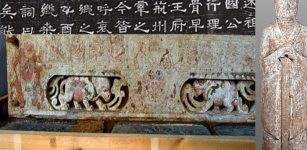 1,500-Year-Old Tomb With Patterns Linked To Zoroastrianism And Buddhism Unearthed In C. China
Archaeology | Jan 19, 2021
1,500-Year-Old Tomb With Patterns Linked To Zoroastrianism And Buddhism Unearthed In C. China
Archaeology | Jan 19, 2021 -
 Stolen Artifacts Returned To Pompeii – Believed To Be Cursed -They Brought Misfortunes To A Woman And Her Family
Artifacts | Oct 13, 2020
Stolen Artifacts Returned To Pompeii – Believed To Be Cursed -They Brought Misfortunes To A Woman And Her Family
Artifacts | Oct 13, 2020 -
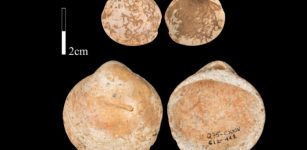 Perforated Shells Were Used By Humans 120,000 Years Ago
Archaeology | Jul 10, 2020
Perforated Shells Were Used By Humans 120,000 Years Ago
Archaeology | Jul 10, 2020 -
 Ullikummi – Genderless, Blind, Deaf Rock Monster Created For Strategic Purposes In Beliefs Of Hurrian People
Featured Stories | Feb 26, 2025
Ullikummi – Genderless, Blind, Deaf Rock Monster Created For Strategic Purposes In Beliefs Of Hurrian People
Featured Stories | Feb 26, 2025 -
 Modern Humans Inherited DNA From A Mysterious And Unidentified Ancestor
DNA | Aug 7, 2020
Modern Humans Inherited DNA From A Mysterious And Unidentified Ancestor
DNA | Aug 7, 2020 -
 3,000-Year-Old Silver Goblet That May Have Belonged To Mannaea Kingdom – Unearthed
Archaeology | Apr 3, 2019
3,000-Year-Old Silver Goblet That May Have Belonged To Mannaea Kingdom – Unearthed
Archaeology | Apr 3, 2019 -
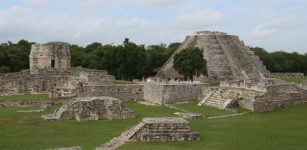 Collapse Of Ancient Mayan Capital Linked To Drought – New Study Suggests
Archaeology | Aug 20, 2022
Collapse Of Ancient Mayan Capital Linked To Drought – New Study Suggests
Archaeology | Aug 20, 2022 -
 Meet SPOT – Robot Dog Deployed To Guard The Ancient Ruins Of Pompeii
News | Apr 1, 2022
Meet SPOT – Robot Dog Deployed To Guard The Ancient Ruins Of Pompeii
News | Apr 1, 2022 -
 Three 3,500-Year-Old Painted Wooden Coffins Discovered In Luxor, Egypt
Archaeology | Dec 3, 2019
Three 3,500-Year-Old Painted Wooden Coffins Discovered In Luxor, Egypt
Archaeology | Dec 3, 2019 -
 Fairies Weren’t Always Cute – They Used To Drink Human Blood And Kidnap Children
Featured Stories | Oct 15, 2022
Fairies Weren’t Always Cute – They Used To Drink Human Blood And Kidnap Children
Featured Stories | Oct 15, 2022 -
 Has World’s Oldest Image Of Virgin Mary Been Discovered In Dura-Europos Church?
Archaeology | Mar 17, 2017
Has World’s Oldest Image Of Virgin Mary Been Discovered In Dura-Europos Church?
Archaeology | Mar 17, 2017 -
 Herculaneum Time Capsule: Ancient Scrolls With Secrets Buried Under Volcanic Ash And Stones
Civilizations | Aug 24, 2016
Herculaneum Time Capsule: Ancient Scrolls With Secrets Buried Under Volcanic Ash And Stones
Civilizations | Aug 24, 2016 -
 Seti I – Remarkable Pharaoh Who Saved The Kingdom Of Egypt And Gave It New Glory
History | Jun 15, 2021
Seti I – Remarkable Pharaoh Who Saved The Kingdom Of Egypt And Gave It New Glory
History | Jun 15, 2021 -
 Arian Tower: Pyramid-Shaped Mausoleum Of Nobleman Was Built On Top Of Medieval Hill Fort
Archaeology | May 19, 2018
Arian Tower: Pyramid-Shaped Mausoleum Of Nobleman Was Built On Top Of Medieval Hill Fort
Archaeology | May 19, 2018 -
 What Was The Symbolism Behind Native American Feathers?
Ancient History Facts | Apr 21, 2017
What Was The Symbolism Behind Native American Feathers?
Ancient History Facts | Apr 21, 2017 -
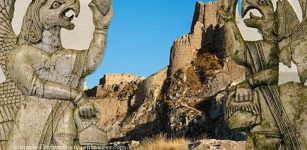 Ancient Settlement Inhabited By Urartian People – Unearthed
Archaeology | Oct 13, 2020
Ancient Settlement Inhabited By Urartian People – Unearthed
Archaeology | Oct 13, 2020 -
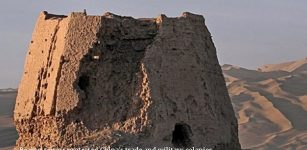 Nine Great Wall Beacon Towers Discovered In China’s Inner Mongolia
Archaeology | Apr 21, 2020
Nine Great Wall Beacon Towers Discovered In China’s Inner Mongolia
Archaeology | Apr 21, 2020


